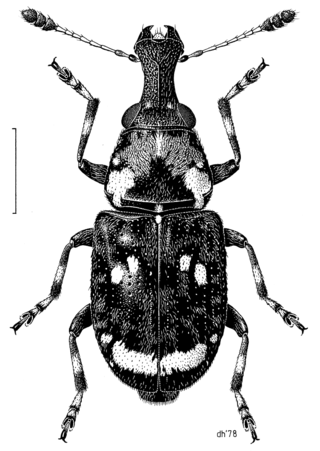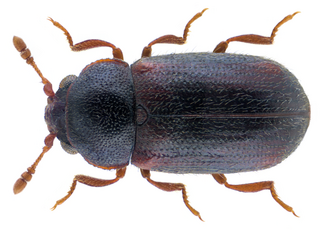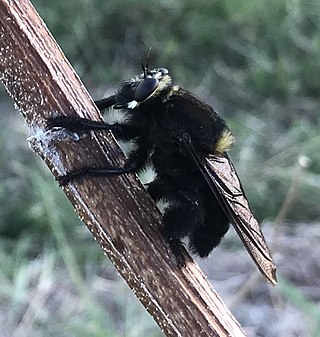
The Verbenaceae, the verbena family or vervain family, is a family of mainly tropical flowering plants. It contains trees, shrubs, and herbs notable for heads, spikes, or clusters of small flowers, many of which have an aromatic smell.

The Asilidae are the robber fly family, also called assassin flies. They are powerfully built, bristly flies with a short, stout proboscis enclosing the sharp, sucking hypopharynx. The name "robber flies" reflects their expert predatory habits; they feed mainly or exclusively on other insects and, as a rule, they wait in ambush and catch their prey in flight.

Cryptophagidae is a family of beetles with representatives found in all biogeographic realms. Members of this family are commonly called silken fungus beetles and both adults and larvae appear to feed exclusively on fungi although in a wide variety of habitats and situations, such as rotting wood and shed animal fur and feathers. These beetles vary from about 1 to 11 millimeters long, and usually have an oval body shape with a slight "waist".

Anthribidae is a family of beetles also known as fungus weevils. The antennae are not elbowed, may occasionally be longer than the body and thread-like, and can be the longest of any members of Curculionoidea. As in the Nemonychidae, the labrum appears as a separate segment to the clypeus, and the maxillary palps are long and projecting.

Myopsocidae is a family of mouse-like barklice, belonging to the infraorder Psocetae of the order Psocodea. This family is closely related to Psocidae, with which it shares similar wing-venation, but from which it is distinguished by three-segmented tarsi.

Sphindidae is a family of beetles, in the suborder Polyphaga. They are called slime mold beetles due to their exclusive feeding on slime molds during adult and larval stages, other aspects of their life history are obscure. Palaeontological discoveries since 2015 have added to the geologic history of Sphindidae, including the discovery of Libanopsis, placed in the extinct subfamily Libanopsinae.

Lyncina vitellus, common name : the calf cowry or the Pacific deer cowry, is a species of sea snail, a cowry, a marine gastropod mollusk in the family Cypraeidae, the cowries.

Trachyderini is a tribe of long-horned beetles in the family Cerambycidae. There are at least 140 genera and 650 described species in Trachyderini.

Cyclocephala is a genus of scarab beetles from the subfamily Dynastinae. Beetles of this genus occur from southeastern Canada to Argentina, India and the West Indies.

Periscelididae is a family of flies.

Mallophora is a genus of bee killers in the family Asilidae. There are about 60 described species in Mallophora.
Megachile orcina is a species of bee in the family Megachilidae. It was described by Vachal in 1908.
Erebus orcina is a moth of the family Erebidae. It is found in Indonesia (Moluccas).
The canton of Dieulefit is an administrative division of the Drôme department, southeastern France. Its borders were modified at the French canton reorganisation which came into effect in March 2015. Its seat is in Dieulefit.

Mallophora fautrix is a species of robber fly in the family Asilidae.
Mallophora atra, the black bee killer, is a species of robber flies in the family Asilidae.

Mallophora leschenaulti, known generally as the belzebul bee-eater or black bee killer, is a species of robber fly in the family Asilidae, Seen in northern Nevada, and Tahoe area.
Mallophora ruficauda is a species of parasitic robber fly in the family Asilidae, endemic to South and Central America. Like other robber flies, M. ruficauda is known for its aggressive behavior and predation upon other insects, especially bees. M. ruficauda mimics a bumblebee to fool predators into thinking it has a painful sting and is not worth eating.

Dicrastylis rugosifolia is a species of plant within the genus, Dicrastylis, in the family Lamiaceae. It is endemic to the south-west of Western Australia.















